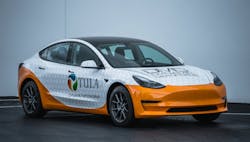Increasing EV Powertrain Efficiency Without Rare-Earth Materials
What you'll learn:
- Other available options for permanent-magnet motors that use rare-earth materials.
- What is an EESM?
- Tula's DMD alternative to achieve EV powertrain efficiency.
The scale of automotive electrification continues to expand at an amazing pace. Automakers as well as countries have pledged to phase out development of internal combustion engines (ICEs) and move forward to all-electric solutions as early as the 2030s.
Nevertheless, electric vehicles (EVs) still face various technical challenges. Improving the efficiency and lowering the cost of EV powertrains are near, if not at, the top of the list. Increasing EV powertrain efficiency plays an important role in reducing grid load, decreasing pollution from electricity generation, and extending the driving distance per charge. However, efficiency advances over the past decade have focused on technologies that also increase rare-earth metal usage.
Rarity of Rare-Earth Materials
An estimated 90% of EVs today have permanent-magnet (PM) motors. PM motors are problematic because there’s a supply shortage of rare-earth materials (e.g., neodymium and niobium). Rare-earth elements are also essential components of products such as cellular telephones, computer hard drives, hybrid vehicles, and flat-screen monitors and televisions.
Moreover, sources of economically recoverable rare-earth metals are concentrated in only a few locations worldwide. About 94% of the rare earths used in the world come from mines in Mountain Pass, California, U.S.; Bayan Obo, Inner Mongolia, China; Shandong province, China; and Sichuan province, China (Source: Encyclopedia Britannica). As a result, most companies are looking for lower-cost alternatives to PM motors, while not sacrificing efficiency.
For EV proliferation to occur at the predicted levels, technological improvements are needed. Possible PM alternatives include switched reluctance motors and wound-rotor synchronous motors.
The EESM Alternative
An externally excited synchronous motor (EESM) consists of a rotor with wound copper wires. Because it requires these wire-wound rotors (as opposed to a stack of metal laminations with magnets), an EESM is often referred to as a wound-rotor design.
Instead of pressing magnets into the laminations, wire coils are wrapped around poles that are inherent in the design of the rotor stack. At the risk of oversimplifying the solution, it can be said that wound-rotor machines essentially replace permanent magnets with copper wire.
Although motors with large amounts of rare-earth material have extremely high levels of peak system efficiency—above 90% or even 95%—their efficiency at lower loads, frequently encountered during EV operation, is often below 70%. This, of course, downgrades overall system performance.
Improving Efficiency without Rare Earths
In an attempt to make EESMs and other rare-earth-free motors as efficient at low speeds as they are at high speeds, Tula Technology developed what it calls Dynamic Motor Drive (DMD). Similar to the concept of Dynamic Skip Fire (DSF) for diesel engines (a trademarked technology by Tula that’s a development of cylinder deactivation), DMD intermittently operates the motor at high efficiency to deliver torque while minimizing losses at low loads. Better still, it does so via a software-only solution.
The concept of DMD is as follows. Through conventional control, maximum energy efficiency is achieved at 25% to 30% of full load operation. However, the efficiency of conventional control falls off dramatically at low loads. Under DMD operation, torque is said to be delivered intermittently at the load that achieves highest efficiency.
The company said that with its optimized pulsing strategy, DMD reduces energy consumption while having no perceptible impact on vehicle noise and vibration. Again, according to Tula and depending on the application, DMD with EESM can lower energy consumption by up to 3%. This efficiency improvement can translate into reduced battery size and cost, or alternatively, increased range.
DMD’s Role in Tomorrow’s Powertrain
In 2022, Tula’s initial DMD application utilized a Chevrolet Bolt with an unmodified permanent-magnet synchronous motor (PMSM) drive unit. Testing showed that DMD meaningfully improved the Bolt’s energy consumption while maintaining drive quality, demonstrating the value of DMD in PMSM applications.
Tula has now demonstrated the feasibility of DMD in two vehicles with fundamentally different electric propulsion systems. It's currently building an EESM-equipped Tesla Model 3 demonstrator to showcase the full capability of DMD.
The company retrofitted the PMSM in the Tesla Model 3 with a wound rotor to create the EESM. It then incorporated the proprietary DMD control logic to reduce energy consumption and improve overall system efficiency. It plans to demonstrate its Dynamic Motor Drive at the upcoming Vienna Motor Symposium. A Tesla Model 3 retrofitted with DMD and EESM will be available for test drives.
Tula argues that DMD provides an affordable software efficiency solution, free from the environmental and cost impacts of rare-earth metals. It’s shown that working at a torque request of 12% load can be achieved by operating at a more efficient 24% load, but with a 50% duty cycle. This enables the overall efficiency, even at low loads, to approach the levels only previously possible at high loads on the drive cycle, translating into a 3% efficiency gain on the EPA’s multi-cycle test.
According to Tula, the EESM and DMD combination is far less expensive and more efficient than the industry-standard PM, with or without an inverter designed with silicon-carbide (SiC) field-effect transistors (FETs). Furthermore, the company says, it carries $150 to $200 less cost at a system level.
The Benefits of DMD-Based Powertrain
With the rush to electrification, rare-earth magnet dependence, range anxiety, and battery costs are still looming issues. The benefits brought by DMD are twofold. For end-users, it can mean less energy consumption, and thus cheaper utility bills. For manufacturers, it can mean less battery capacity for the same distance, and together with the magnet-free design, results in savings of several hundred U.S. dollars on vehicle cost.
Perhaps of equal importance, these improvements are achieved with an easily implemented software change in conventional controllers operating with conventional inverters. Members of Tula’s DMD development team will present a paper on their DMD findings at the Vienna Motor Symposium.

